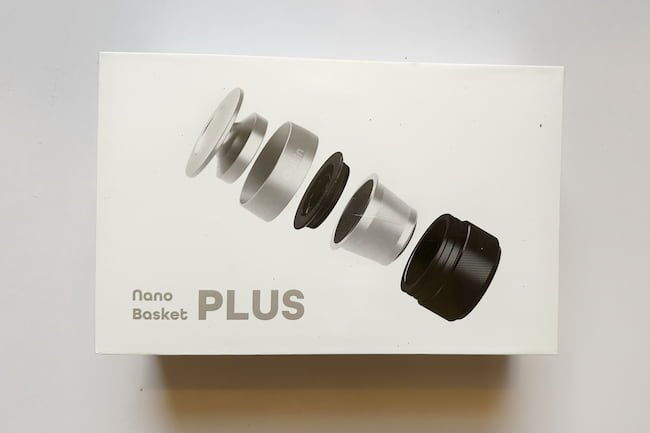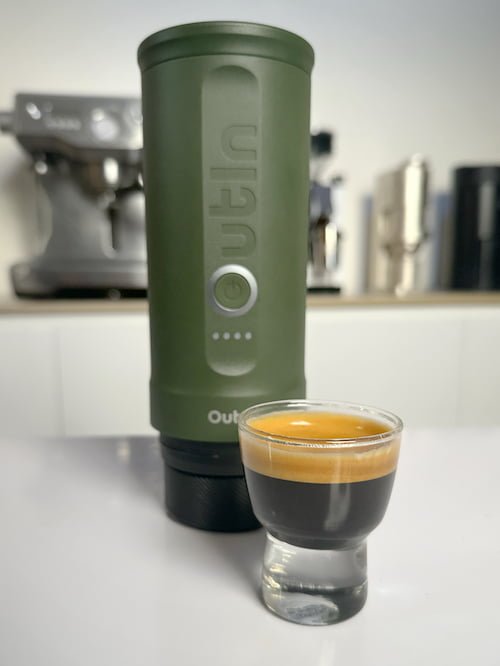When I first saw the Outin Nano, I thought, “There’s no way this thing can be any good.”
After all, it looks a bit like a colorful thermos and promises things that just seem too good to be true.
For a couple of years, the brand has actually reached out to me offering a test unit. I never really felt that compelled.
But curiosity (and perhaps a moment of weakness) finally got the best of me.
I’m happy I gave it a try because this experience has made me re-evaluate a lot of what I thought I knew about coffee and manual espresso.
So, buckle up, because we’re going to take a close look at this portable espresso maker and see if it delivers in the cup.
A unique portable espresso maker

First Impressions
Initially, I expected the Outin Nano Portable Espresso Maker to be somewhat generic. With so many new coffee brands on the market, it’s easy to assume a new product might not stand out.
However, my expectations were surpassed upon opening the box.
The unboxing experience of the Outin Nano is thoughtfully designed. Instead of having just the usual boring instruction leaflet and uninspired design, the box includes high-quality graphics and images.


There’s an instruction insert that features simple pictograms to explain how to use the device, so it doesn’t feel intimidating for new users.
This touch tells me that the brand might be a few steps ahead of the more “generic” coffee brands that have flooded the market recently.
However, more skilled home-baristas will likely find the instructions unnecessary due to the straightforward nature of the device. It’s basically just add water to the reservoir, at the top, screw in a basket with either a capsule or ground coffee, and then press a button.
Inside the Box
Everything inside the box is neatly packed and well-protected. The contents include:
- A basket designed to use capsules such as those from Nespresso
- A pressurized basket that can fit 7-8 grams of ground coffee
Personally, I think the pressurized basket is on the small side, but I guess it can be a way to give non-initiated folks a quick glimpse into the work of home espresso.
“Nano Basket Plus” Upgrade Kit
However, I was lucky that the company also sent me the real star of the show: their newly released “Nano Basket Plus” upgrade kit.
This kit is a bit of a game-changer and I highly recommend that you get it if you’re just a little bit serious about drinking espresso (be aware, you need an espresso grinder to really get the best out of it…).
This set includes a high-quality unpressurized basket, a funnel for mess-free loading, a WDT tool that is used to “rake” the grounds and break up any clumps, and a stylish palm tamper featuring a ripple base.
That’s basically everything you need to make more serious espresso, including the most important accessories.

I think this kit is well worth the price if you have a good grinder at home, and you’re someone who takes espresso seriously.
The included pressurized basket just isn’t worth the effort (for me at least) with its tiny capacity and low extraction potential.
It takes some planning and effort to bring a coffee grinder and the Outin Nano on the road, so I don’t see any reason to go through all that to get a thin 15 ml shot. But with an “authentic” double basket you’ll be rewarded with a bigger shot that can keep you caffeinated for a while!
Usage & Modes
The Nano has two main modes of operation:
Manual Mode
To use the Nano in its most basic form, simply fill the reservoir with boiling water, give the button a quick double press, and watch as the machine springs into action, leveraging its built-in pump to generate authentic espresso pressure.
In this mode, the Nano doesn’t use much battery power, allowing you to pull shots for weeks or even a month on a single charge. The company claims that it works for 100 cycles.
While I haven’t tested this claim, it did perform admirably in my time using the device. However, it’s worth noting that preheating the device is a good idea. So if you run a preheat cycle before each shot, that will make the battery life half as long.

Self-Heating Mode
For those who really like to drink coffee off the grid, the Nano’s self-heating mode is a bit of a game-changer. Hold the button down for a couple of seconds, and then you enter the machine’s self-heating system, which brings the water up to brewing temp.
This feature sets the Nano apart from all other portable espresso makers I have tested.
While this mode does consume more power (limiting you to 2-3 shots per charge), the freedom it affords is genuinely remarkable. It already saved me one time where I had to wait for hours in a government office early in the morning.
Workflow, Shot Pull & Taste
During my testing period, I have been using the Nano with capsules and the Pro Kit. The resulting espresso with the Pro Kit was a pleasant surprise – sweet, balanced, and full-bodied. I was consistently achieving at least 20% extraction yield throughout my testing, which is admirable for a gadget that I at first glance didn’t expect much from.

However, it should be said that I used dark roasts for my testing.
The device doesn’t quite get hot enough to handle light/medium roasts. And while the regular double basket is good, it’s still quite far from precision baskets or even regular 58 mm baskets.
The basket is tall but not wide, which can definitely work and give you good shots, but it does limit you to a more coarse grind size. The number of holes is also much lower than for example a 58 mm IMS or VST basket.
It’s still a real espresso basket, though, and you can get beautiful crema, but just know that you have to grind a touch coarser than what you’d do with a generic 51 mm basket.
So when you combine this slightly coarser grind size with slightly lower temperatures, that means you’re more limited in terms of extraction potential and should stick to medium-dark/dark roasts. And this point is a perfect segue into the next topic.
Temperature and Preheating
To get a better understanding of the Outin Nano, I conducted a series of temperature tests, comparing its performance to that of the Leverpresso and the Lelit MaraX.
The results were illuminating: If you’re using manual mode it’s a good idea to preheat the Nano. It looks like you’ll get a brewing temperature that’s around 6-8 degrees hotter (Celsius) by doing this.
So it means that you’ll be closer to proper espresso brewing temperature. While I’m unsure of the exact brewing temperature of the Outin Nano, from my tests I can conclude that it’s probably a few degrees cooler than the Leverpresso V4, which I know very well.
The good news is that the Outin Nano’s self-heating system really works well – it achieves the same brewing temperature as if you had done one preheat cycle.

Comparison: Outin Nano vs Other Portable Espresso Makers
In my time reviewing portable espresso makers, the Outin Nano has distinguished itself from the competition. With its user-friendly pump-driven operation and self-heating capability, it offers a level of convenience and flexibility that sets it apart from the crowd.
At 658 grams (0.6 kg), the Nano is in the same weight class as popular rivals like the Picopresso and Leverpresso. While it may be a touch heavier than the Picopresso, the difference of a few hundred grams is hardly noticeable when packed in a suitcase.
However, if you opt for the Pro Basket Kit with its included tamper and funnel, the weight does jump up to 830 grams. Despite this, the Outin Nano boasts a significant advantage over its competitors: the built-in self-heating system. This feature eliminates the need for an external heat source like an electric kettle, granting you unparalleled freedom and convenience. Whether you’re on the road, in the great outdoors, at the office, or even on public transport, the Nano empowers you to craft top-notch espresso shots with ease.
Another area where the Outin Nano shines is its user-friendliness. With manual devices like the Picopresso, Leverpresso V4, and Cafflano Kompresso, achieving the optimal 7-9 bars of pressure for a perfect shot demands considerable physical exertion.
Users must rely on their own strength or body weight to generate this pressure, which can be quite a workout. In contrast, the Nano streamlines the process with its electric pump.

A quick double press of the button is all it takes, and the pump takes care of the rest. This hands-off approach makes the Outin Nano incredibly accessible, allowing you to craft excellent espresso without breaking a sweat. This feature also eliminates the need for a stand or a special “extra sturdy” brewing cup as is required with the Kompresso and Leverpresso. You can hold the Nano in your hand, allowing you to use any size of glass or cup you prefer.
This flexibility extends to which espresso scale you’re using – with other manual espresso makers it’s often a headache to find a suitable scale that fits (this is even the case with the Cafelat Robot and various Flair Espresso Makers).
Advanced mode?
But as if all this wasn’t already good enough. I recently started experimenting with pulling lungos, allongés and “sprovers” with the Outin Nano – and it’s very capable in this regard as well.
The water reservoir is limited to around 80 ml of water but there’s nothing stopping you from refilling it while you are brewing. This means that you can technically pull very long shots. I pulled a filter coffee roast at a 1:8 ratio and it tasted great. The slightly lower brew temperature of the Outin Nano also becomes less of an issue when you pull longer shots.
You can also do very long blooms or try to emulate pressure profiling shots by starting and stopping the brewing cycle. Since there’s no 3-way valve releasing pressure and excess brew water you will not disturb the puck by trying these unorthodox techniques.
There aren’t many “traditional” manual espresso makers that offer this level of experimentation.
Conclusion
One thing that strikes me about the Outin Nano is how it has challenged my long-standing love for manual espresso makers. Over the years, I’ve grown fond of the ritual involved in manually pressing out an espresso shot. I’ve even convinced myself that the effort is part of the charm. But now, with the Outin Nano, I have this simplistic device that looks a bit like a thermos. I just press a button, and it almost seems too easy—too good to be true.
As someone who prides themselves on manual espresso skills, this ease of use is almost a conflict with my coffee-brewing identity. We manual espresso enthusiasts like to believe that using levers is superior.
However, I have to admit that my experience with the Outin Nano has yielded excellent results with less effort. So, here I am, questioning my whole coffee lifestyle.
It’s both enlightening and a bit annoying to realize that maybe, just maybe, simplicity and convenience can produce great results too.
So yes, this is a strong recommendation: for the money, especially with the added Pro Basket Kit, the Outin Nano offers something unique in the market. If you want to make espresso on the road, there aren’t many options better than this.
➡️ Check current price on Amazon
➡️ Check current price on Outin Official Site (10% off with this link or by using the code: THECOFFEECHRONICLER)
